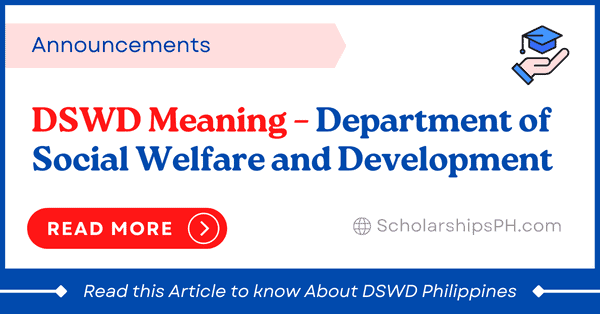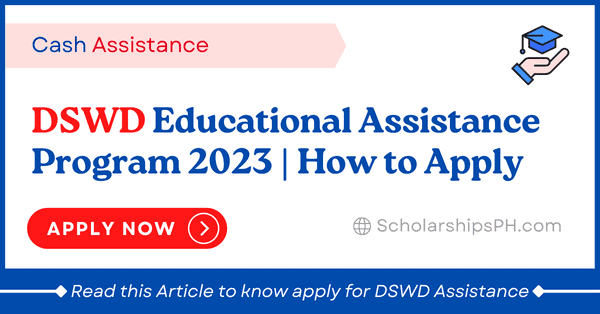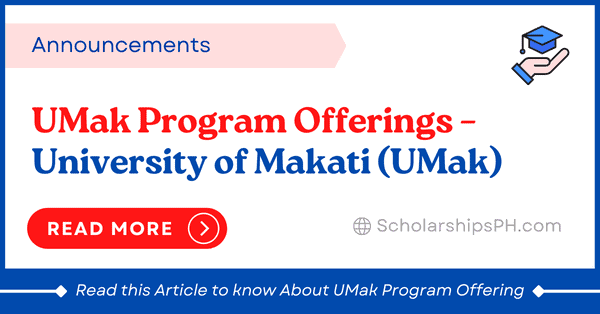⚡Click here for Ongoing College Scholarships 2024-2025⚡
2023 DSWD – Department of Social Welfare and Development
The Department of Social Welfare and Development (DSWD) is a department of the Philippine government charged with promotion and protection of the social welfare and development of Filipinos. Please continue reading if you have any questions regarding what DSWD does or about its programs, services, or functions.

Orphans, abandoned children, street children, people with disabilities, the elderly, women, and indigenous peoples are just a few of the vulnerable groups that the DSWD protects. The department also offers help for relief efforts in times of calamity and disaster.
The DSWD also aims to prevent and reduce poverty through its programs on livelihood, social housing, educational assistance, and cash transfers. They offer a wide range of services and programs that affect the lives of Filipinos from all socioeconomic backgrounds.
Table of Contents
- Overview
- What is DSWD?
- What are the Benefits?
- What is the Mission?
- What is the Vision?
- What is Core Values
- What is DSWD Brand?
- Objectives
- What are the DSWD Programs and Services?
- 1. Foster Care and Adoption
- 2. BUB stands for Bottom-Up Budgeting
- 3. Residential Care Facilities and Centers:
- 4. Disaster Relief Operations
- 5. Development and Gender
- 6. International Social Welfare Services for Filipino Citizens (ISWSFN):
- 7. NCDDP – Kalahi CIDSS
- 8. Listahanan
- 9. PAMANA
- 10. Protective Services Program
- 11. Recovery and Reintegration for Trafficked Persons Program (RRPTP):
- 12. Supplemental Feeding Program
- 13. Sustainable Livelihoods Program(SLP)
- 14. The Pantawid Pamilyang Pilipino Program (4ps)
- Institutions and DSWD Centers
- Documentary Requirements for Admission
- Regional Rehabilitation Center for Youth (RRCY)
- DSWD Regional Haven
- Programs and Services
- FAQs
- Summary
- Contact Information
Overview
Executive Order 123 of President Corazon C. Aquino, issued in 1987, reformed the MSSD and changed its name to the Department of Social Welfare and Development (DSWD).
The Department of Social Welfare and Development (DSWD) name, organizational structure, and functional areas of responsibility were established by Executive Order No. 292, popularly known as the Revised Administration Code of 1987, which also clarified the department’s statutory authority.
The government organization in charge of creating and carrying out social welfare and development programs in the Philippines is called the Department of Social Welfare and Development (DSWD).
What is DSWD?
The executive branch of the Philippine government, known as the Department of Social Welfare and Development (DSWD), is in charge of ensuring the social welfare and development of Filipinos.
What are the Benefits?
The Department of Social Welfare and Development (DSWD) is, legally mandated with creating, administering, and also implementing comprehensive social welfare programs aimed at improving the living conditions as well as empowering disabled children, youth, women, seniors, people with disabilities, families in crisis or at risk, and communities in need.
What is the Mission?
The DSWD’s mission statement for the upcoming years is as follows. to assume the initiative in establishing, executing through, and implementing social welfare and development policies and programs for and with the poor, vulnerable, and disadvantaged people.
What is the Vision?
The following is the DSWD vision statement: The Department of Social Welfare and Development wants to see a fair, just, and peaceful society where everyone in the Philippines have access to opportunities and is free from hunger and poverty.
What is Core Values
The DWD Core Values are as follows:
- Maagap at Mapagkalingang Serbisyo;
- Serbisyong Walang Puwang sa Katiwalian;
- Patas na Pagtrato sa Komunidad
What is DSWD Brand?
The DSWD Brand is “DSWD May Malasakit”.
Objectives
The DSWD goals are listed below.
- Improve the capacity of service providers to handle cases involving people, families, groups, or communities.
- To monitor and measure the success of social welfare and development initiatives as well as their effects on cases under supervision, performance indicators should be developed.
- Encourage interactive case management and on-site service providers to solve problems (LGU, NGO and DSWD).
- By offering or making technical support available to supervisory recipients, you can raise employee/agency performance.
What are the DSWD Programs and Services?
Here is a list of DSWD programs and services:
1. Foster Care and Adoption
A minor is permanently adopted with a parent or parents who are not their biological parents.
2. BUB stands for Bottom-Up Budgeting
Bottom-Up Budgeting (BUB) is a procedure that was tested in 2013 and is currently in its third cycle to guarantee the execution of crucial initiatives for reducing poverty.
3. Residential Care Facilities and Centers:
These are round-the-clock programs that offer struggling, underprivileged, and impoverished people or families an alternate family care arrangement.
4. Disaster Relief Operations
It is both a life-saving emergency response and a long-term strategy.
5. Development and Gender
Gender equality refers to relationships between men and women, women and men, men and men, and boys and girls. Gender considerations must be considered when the government plans, funds, implements, monitors, and evaluates development policies, programs, and projects. Gender concerns have an impact on every area of development.
6. International Social Welfare Services for Filipino Citizens (ISWSFN):
The ISWSFN program encourages migrant Filipinos and other Filipino foreign nationals who require special protection to seek assistance from Philippine embassies in their destinations.
7. NCDDP – Kalahi CIDSS
The Kapit-Bisig Laban sa Kahirapan – Comprehensive Integrated Delivery of Social Services: Kapangyarihan at Kaunlaran sa Barangay (KALAHI-CIDSS: KKB) is a community-driven flagship development project of the government of the Philippines that aims to empower societies through direct part in community projects aimed at reducing poverty. Its goal is to provide human development services, asset reforms, growth of capacity, and participation in government.
8. Listahanan
It is a data management system that identifies the impoverished and their geographic distribution across the nation. The National Household Targeting System for Poverty Reduction oversees its management (NHTS-PR).
9. PAMANA
PAMANA (Payapa at Masaganang Pamayanan) aims to enhance access to basic social services for underprivileged communities while also promoting responsive governance.
10. Protective Services Program
Communities that are vulnerable or disaster-affected as well as people, families, and communities in crisis or challenging situations receive a range of interventions through the Assistance to Individuals in Crisis Situations (AICS) and Assistance to Communities in Needs (ACN) programs.
11. Recovery and Reintegration for Trafficked Persons Program (RRPTP):
A wide range of activities and services make up the Recovery and Reintegration Program for Trafficked Persons (RRTP), which was created to address the psychosocial and material requirements of its participants.
12. Supplemental Feeding Program
As part of the DSWD’s ECCD program, it is a government-sponsored project that gives children food in addition to their normal meals.
13. Sustainable Livelihoods Program(SLP)
The Sustainable Livelihood Initiative (SLP) is a community-based program that builds capacity with the goal of enhancing the socioeconomic circumstances of program participants.
The implementation of SLP involves a two-track program. The Microenterprise Development Track is the initial track, and it helps microenterprises become more economically and organizationally viable. The second track—Employment Facilitation—helps individuals identify acceptable employment possibilities in the meanwhile.
14. The Pantawid Pamilyang Pilipino Program (4ps)
The Pantawid Pamilyang Pilipino Program, sometimes referred to as the “4Ps,” is a human development initiative that spends money on the health and education of low-income families, mainly those with children ages 0 to 18.
Institutions and DSWD Centers
Reception and Study Center for Children (RSCC)
The Reception and Study Center for Children (RSCC) is a 24-hour residential facility for children aged 0 to 6. It offers protection and rehabilitation services to neglected, abandoned, abused, and exploited children through temporary residential care, as well as to children with particular needs, such as at-risk children and children in need of alternative family care.
Additionally, it provides appropriate and responsive social work intervention and help to address the safety and security needs of very young children who have experienced abuse as well as their growth and development.
In order to improve case management, appropriate placement, and other child rehabilitation services, RSCC also aims to enhance the competency and effectiveness of its staff members and service providers.
Objective: The goal is to care for and safeguard abused, abandoned, and dependent young children (ages 0–6), as well as children with special needs and those who have been neglected, relying, or dependent on others.
Target Client
Children from 0 to 6 are served at the Reception and Study Center for Children. These kids fall under one of the following categories:
Abandoned/Neglected Children: Children who have been abandoned or neglected by their parents are those who are being looked after by private individuals or organizations, such as hospitals, clinics, or properly licensed child care or placement agencies.
Dependent Children: Because their parents are temporarily unable to care for them, these kids have no known relatives who can take care of them.
The inability of parents to care for their children may be caused by the following conditions:
- The parent(s) is currently in prison.
- Due to a lack of financial resources, parents are temporarily unable to meet their children’s demands.
- The parent(s) must attend to urgent family matters and will be gone for an extended period of time.
- The parent(s) is in the hospital or is otherwise unable to work.
Foundling: This applies to kids who are abandoned in open or closed spaces, such the streets. These kids are subjected to physical abuse. The streets provide moral, physical, and environmental concerns.
Orphaned Children – These kids don’t have any family or other relatives who can take care of them.
Transnational: These are children between the ages of 0 and 6 who are the offspring of a Filipino and a foreign national relationship.
Programs and Services
Adoption is a socio-legal procedure in which a kid who has been voluntarily committed or deemed abandoned finds a permanent home/family.
Foster Care Services: A licensed foster family provides organized replacement parental care to a kid when the child’s biological parents are temporarily unable to care for the child.
Educational Services: It involves the delivery of formal and non-formal education, remedial programs, and socio-cultural services and activities to children with special needs depending on their capabilities and needs.
Home Life Services: Home Life Services works to create a warm setting where kids can learn about family life. It meets children’s physical, emotional, mental, social, and spiritual requirements by giving them food, clothing, and shelter as well as well-planned activities that foster a family-like environment.
Psychological Services: Abuse and neglect can have a long-term and significant impact on a child’s physical, emotional, and psychological well-being. Children can cope with and overcome the impact of traumatic events and experiences by participating in psychological sessions. It entails conducting psychological assessments to assess a child’s personality and intellectual make-up in order to develop an appropriate treatment plan or therapy program.
Legal Guardianship: It is a socio-legal procedure that appoints a kid and his or her property to offer substitute parental care until the child achieves the age of majority.
Health Services: It involves the provision of therapeutic and preventive interventions with the intention of enhancing well-being and reducing illness and morbidity. Examples include regular physical examinations, immunizations, deworming, growth monitoring, vitamin supplements, environmental health and sanitation, inpatient and outpatient consultations, dental work, and physical therapy.
Documentary Requirements for Admission
- Case Summary
- Medical Abstract/Certificate
- Birth Certificate (if available)
- Medico Legal- if sexually/physically abused
- Police/Barangay blotter and affidavit of finder or referring party if abandoned/foundling.
- Referral Letter
Regional Rehabilitation Center for Youth (RRCY)
Children in Conflict with the Law (CICL) whose sentences have been suspended can receive intense rehabilitation in a residential setting at the RRCY. It offers a secure and encouraging setting for attempting to rehabilitate kids.
The DSWD also offers community-based rehabilitation programs, while the RRCY offers institutional rehabilitation for the CICL. When it is possible, the RRCY links its center-based services to community-based programs or projects developed in the community with the aim of intervention, diversion (from formal court procedures), and rehabilitation of the CICL for full reintegration into his family and community.
Objective: Treatment and rehabilitative programs are created to enhance the psychological, emotional, and psychosocial health of Children in Conflict with the Law (CICL).
Target Client: A CICL male between the ages of 15 and 18 who has committed an offense and been ordered by the court to undergo rehabilitation at the DSWD facility is the target client (RRCY).
CICL serving a suspended sentence may be required by the court to take part in any or all of the disposition measures that are suitable for their rehabilitation and general welfare.
A VALID COURT ORDER ISSUED AFTER A HEARING FOR THIS PURPOSE IS REQUIRED FOR ANY CHILD TO BE ADMITTED INTO A REHABILITATION FACILITY. (sec. 45, RA 9344)
Programs and Services: The RRCY offers CICL a balanced, structured, informal home environment and group living arrangement.
CICL are also given the chance to engage in income-generating activities so they can increase their financial security. Specifically, the following is provided to CICL:
Support Services and Interventions
- Health Services: Giving clients the proper medical attention is a part of this.
- Recreational Programs: Taking up a hobby or practicing a creative skill, such playing an instrument, singing, dancing, or engaging in athletics, can be used as a coping mechanism and a substitute activity to boost one’s sense of competence, self-worth, and identity.
- Psychological Services: It involves a detailed evaluation of the child’s behavior and personality as well as psychological testing in collaboration with partner organizations.
- Home life Services: This gives the customers a feeling of being at home and promotes moral growth.
- Educational Services: This requires the formation as well as implementation of a comprehensive plan that provides a learning environment and opportunities for each client.
- Social Services: The CICL in charge of the RRCY received expert help twenty-four hours per day, seven days per week. From admission to discharge, this comprises therapy intended to improve clients’ social skills and get them ready for family reunification.
- Spiritual Enhancement Program: There are regular religious services and gatherings.
Treatment Interventions
- Milieu Therapy
- Counseling Services
- Behavioral Modification
- Therapeutic Community
DSWD Regional Haven
The DSWD-Regional Haven is a center-based program that provides strong, disadvantaged, and mistreated women with safe custody and psychological care.
DSWD-Regional Haven offers a continual stream of fundamental services through a group of social workers, psychologists, house parents, and other experts who collaborate with clients to create a loving atmosphere in which trust, identity, and healing can develop.
Objective
It is important to safeguard and provide appropriate intervention and rehabilitation services to victims of violence, abuse, or exploitation.
Target Client
The target market includes women and girls between the ages of 7 and 17 as well as ladies between the ages of 18 and 59. These are listed below:
- Abandoned / Neglected: Girls (minors) who have experienced hardship and have been abandoned by their family or relatives.
- Battered / Abused: women and girls who, for a number of causes, have experienced physical, psychological, or emotional abuse.
- Victims of Illegal Recruitment: women who were harassed after being hired, typically for free, for various local or foreign jobs.
- Victim of Involuntary / Forced Prostitution: Girls and women who are hired for various tasks yet are forced into prostitution.
- Others – These standees include individuals who are searching for long-lost relatives or who are experiencing a crisis and require prompt medical attention.
Programs and Services
Survival and Protection Services
Legal Services: This will help residents during court hearings and other legal issues.
Character Building Program: This program encourages the formation and strengthening of values and characters by focusing on desirable characteristics. This aids in the development of sound decisions based on universal fundamental principles.
After Care Services: It is viewed as a continuation of the rehabilitation process in the community following discharge from the center
Food, Nutrition, and Health Services: It provides adequate nutrition and meals to people in order to maintain their health.
Medical Services: This includes providing appropriate medical care to clients..
Home life Services: The client is introduced to a home-like setting that promotes moral development.
Spiritual Enhancement Program – Religious services and activities are held on a regular basis.
Social Services – Women and children in Particularly Difficult Circumstances (WEDC / CEDC) in care at the Regional Haven receive social assistance 24 hours a day, seven days a week. This includes interventions aimed at restoring and developing clients’ social functioning from the time they are admitted to the time they are released, as well as preparing them for reintegration into their families.
Family Counseling: This focuses on assisting the client’s family members in dealing with fears, frustrations, and trauma, among other things, as well as strengthening their family’s ability to solve their problem.
Psychological / Psychiatric Services: It entails a thorough examination and evaluation of the child’s personality and behaviour in collaboration with other organizations that use psychological evaluation and testing.
Recreational Programs – Individuals might utilize developing a hobby or creative talent, such as athletics, singing, dancing, or playing instruments, as a coping mechanism and an alternative activity to make them feel more competent, self-worth, and sense of identity.
Development and Participation Services
Educational Services – This involves creating and implementing a detailed plan that provides a learning environment and opportunities for each client.
Individual and Group Counseling – It helps residents improve their interpersonal relationships while also making them more aware of their flaws and abilities.
Productivity and Skills Training – This programme aims to teach and improve client skills in order to prepare them for a self-sufficient life.
Spiritual Services and Value Formation – This factor requires consistency in assisting clients from and by specific religious groups with their spiritual needs.
Sports, Creative Arts, and Recreational Activities – It is a coping technique and alternative activity that aims to foster feelings of competence, self-worth, and identity through the development of a passion or creative talent such as athletics, singing, dancing, or playing instruments.
FAQs
What is DSWD?
The Department of Social Welfare and Development (DSWD) is in charge of developing, administering, and implementing comprehensive social welfare program aimed at improving the living conditions of disadvantaged children, youth, women, seniors, people with disabilities, and underserved communities.
What is the DSWD contact number
The DSWD contact number is (632) 931-8101 to 07.
What are the DSWD Programs
→ Adoption Unit. Alternative Family Care Program. Domestic Adoption.
→ Minors Travelling Abroad.
→ Recovery and Reintegration Program of Trafficked Persons.
→ Social Pension Program for Indigent Senior Citizens.
→ Supplementary Feeding Program
When was DSWD Established?
The DSWD Established was in November 1, 1939
What is envision of DSWD?
We envision a society in which the poor, vulnerable, and disadvantaged are empowered to live better lives.
What is the DSWD Email address?
The DSWD email address is [email protected].
Can I go straight to DSWD?
Yes, you can go straight to DSWD. The DSWD office is open from 8:00 a.m. to 5:00 p.m., Monday through Friday.
What is the DSWD hotline number?
You can reach the DSWD by calling (632) 931-8101 to 07.
What is the goal of DSWD?
The Department of Social Welfare’s mission is to develop, administer, and implement comprehensive social welfare program that improve living conditions and empower disadvantaged children, youth, women, seniors, people with disabilities, families in crisis or at risk, and communities in need.
What is the DSWD cash assistance amount?
The chosen beneficiaries will receive cash assistance in the amount of Three Thousand Pesos (PHP 3,000.00) to help them meet their basic needs and those of their families.
Who is eligible for DSWD financial assistance?
Indigent, vulnerable, disadvantaged, or poor families/individuals in the informal sector as determined by the DSWD Listahanan, government employees and contract service workers, and those in crisis as determined by social workers
How do I gain internet access to SAP DSWD?
SAP beneficiaries can register themselves online at www.reliefagad.ph. The mobile application can be accessed via a mobile or desktop browser. Then, to get started, click register.
When is DSWD named?
In 1987 Under President Corazon C. Aquino’s Executive Order 123, the MSSD was reorganized and renamed the Department of Social Welfare and Development (DSWD).
What is DSDWD vision all the Filipinos?
The DSWD vision statement will be as follows: “The Department of Social Welfare and Development envisions all Filipinos free of hunger and poverty, with equal access to opportunities enabled by a fair, just, and peaceful society.”
Where can I ask for financial assistance in the Philippines?
The DSWD provides medical and Hospitalisation assistance to people in crisis, indigent (as determined by their barangay), and those who have not used their Crisis Unit Intervention assistance within a year.
Who is considered indigent in the Philippines?
Those whose monthly family income does not exceed P14,000.00 in Metro Manila, and those whose monthly family income does not exceed P13,000.00 in other regions.
NOTE: Those whose monthly family income does not exceed P14,000.00 in Metro Manila, and those whose monthly family income does not exceed P13,000.00 in other regions.
Summary
The executive branch of government is in charge of ensuring the social welfare and development of Filipinos, and it does so through the Department of Social Welfare and Development (DSWD).
The Revised Administration Code of 1987, also known as DSWD Executive Order No. 292, established the DSWD’s name, organizational structure, and functional areas of responsibility. The Department of Social Welfare and Development (DSWD) is legally mandated to create, administer, and carry out comprehensive social welfare program aimed at improving the living standards of disadvantaged children, youth, women, elders, people with disabilities, and underserved communities.
Contact Information
- DSWD Office
- Address: DSWD Building, Constitution Hills, Batasan Complex, Quezon City
- E-mail address: [email protected]
- Telephone Number: (632) 931-8101 to 07
- Website: http://www.dswd.gov.ph/
- Facebook Page: https://www.facebook.com/dswdserves



